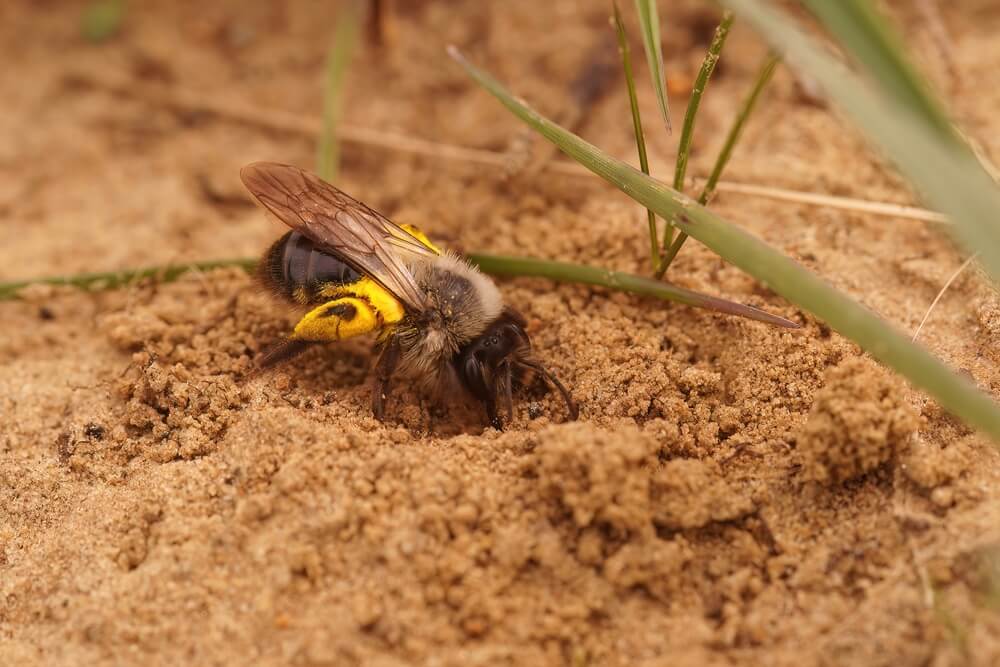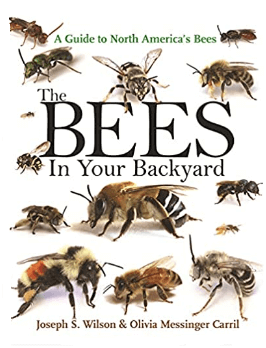Table of Contents:
What are Miner Bees?
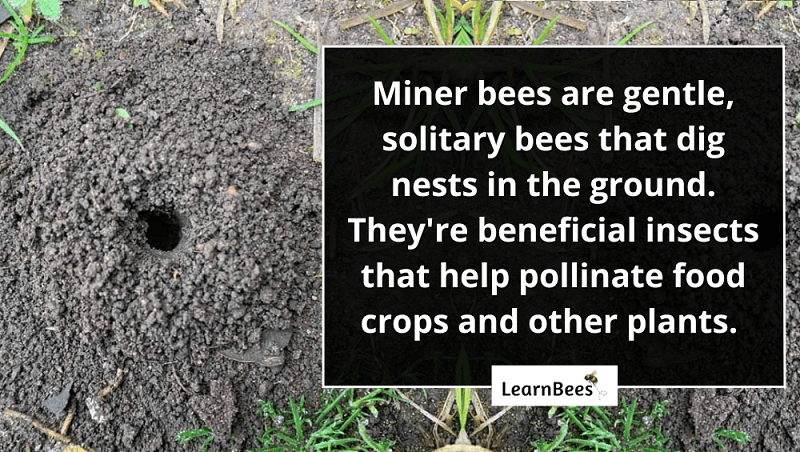
Miner bees (Anthophora abrupta) are a type of bee that digs holes in the ground for their nests.
The bees are gentle and small, with fuzz covering their bodies. They’re also solitary bees that live alone, unlike honeybees and bumblebees.
But here’s the thing:
The term “miner bee” is a general one that refers to bees that nest underground.
They belong to a group with more than 1,200 species. They’re also called mining bees, digger bees, ground bees, and dirt bees.
As their name suggests, miner bees dig their tunnels in areas with open dirt. The best way to deter miner bees from your yard is to ensure your grass is thick with no open dirt patches.
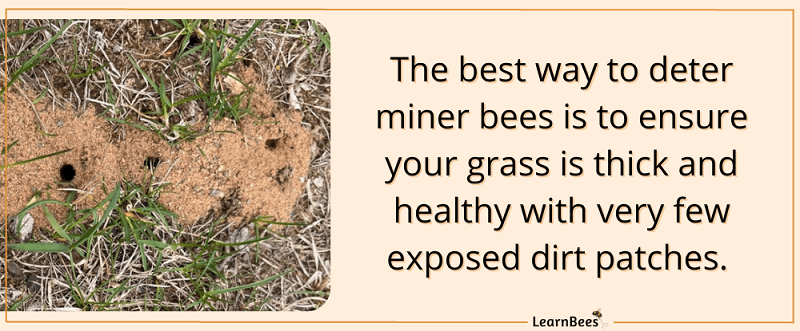
With that said:
Miner bees are in no way harmful to your yard.
In fact, the opposite is true.
Miner bees are vital pollinators that help aerate your soil and put food on your table. We can thank bees for coffee, blueberries, cherries, almonds, broccoli, tomatoes, and many more foods.
This is why bees are considered a keystone species.
A keystone species is the glue that helps hold ecosystems together. Without bees, the habitat would drastically change, and food shortages would ensue.
So, while miner bees make up a small percentage of the world’s animals, they play a significant role in our lives.
Miner bees are attracted to flowers like zinnia, celosia, phlox, and catmint. Planting a bee-friendly garden is a great way to help these essential pollinators.
Are Miner Bees Harmful?
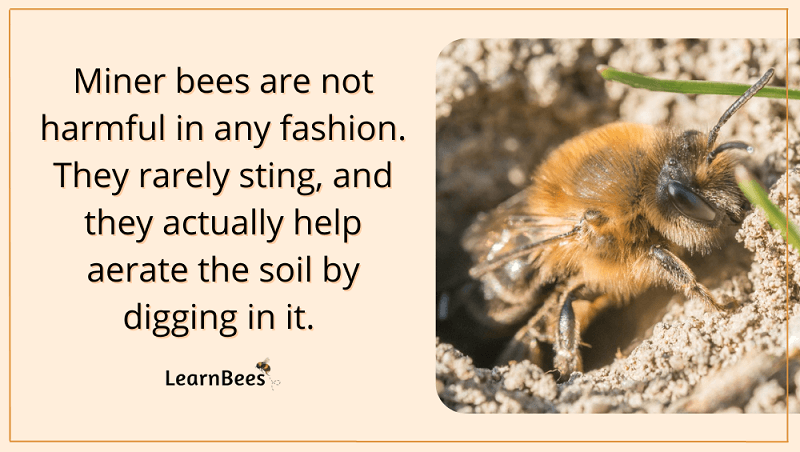
Miner bees are not harmful to you or your yard. They’re gentle bees that rarely sting.
Better yet?
Miner bees would rather fly away from threats instead of confronting them.
Additionally:
Only female miner bees can sting. Male miner bees cannot because they don’t have stingers.
Stingers are actually modified egg-laying organs, so only female bees have them. But besides being gentle-natured, female miner bees are typically too busy to bother with stinging.
Remember:
Miner bees are solitary bees that don’t live in colonies. As such, they’re responsible for building their own nest, laying eggs, collecting food and water, and protecting the baby bees from other insects.
To put it simply?
Miner bees are too occupied with their duties to worry about bothering humans.
And aside from the fact that they’re incredible pollinators, miner bees also help aerate your lawn. Lawn aeration happens when you puncture the soil with tiny holes to allow water, air, and nutrients to encourage the growth of grass.
How Long Do Miner Bees Last?
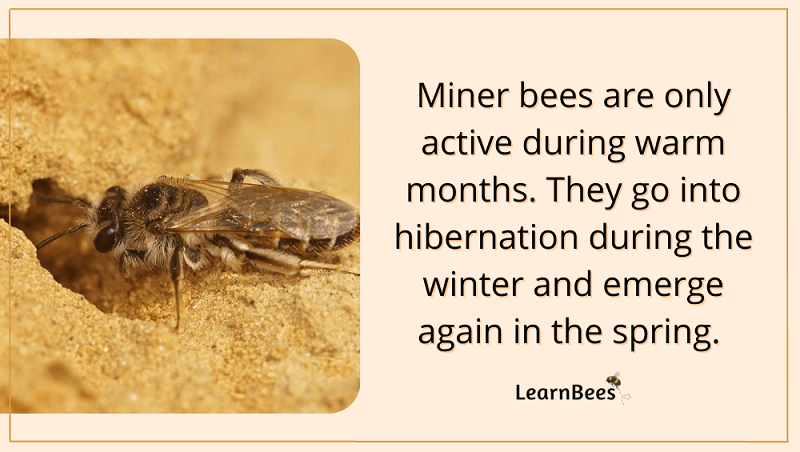
Miner bees have short but busy lifespans, only lasting four to six weeks.
Mining bees are most active in the spring and early summer but can also be present in the fall. Once winter arrives and temperatures drop, miner bees will hibernate until spring.
The best thing to do is give miner bees their space while they’re active.
If you must deter them, you can do so by seeding your lawn, so it’s full of grass and has very few dirt patches exposed.
More exposed dirt means more miner bees.
You can also sprinkle cinnamon around areas where miner bees nest. This will discourage the bees from nesting there without harming them.
Lastly, keeping the ground wet with a sprinkler system may help deter miner bees. Miner bees prefer to nest in dry, well-draining soils.
Most importantly?
Avoid using pesticides or harmful chemicals of any kind. Miner bees are a crucial part of our ecosystems, and we should protect them. The best thing to do is co-habitat peacefully with these gentle pollinators.
After all, we do need them.
FAQs on Miner Bees
- Can I mow the lawn with mining bees?
- Do miner bees come back every year?
- Do birds eat miner bees?
- Are miner bees aggressive?
- Should I get rid of miner bees?
- Will miner bees sting?
- How do I get rid of miner bees in my yard?
- Where do miner bees go in winter?
- Are mining bees rare?
- Are miner bees good for the garden?
- What flowers do miner bees like?
- Do mining bees sting dogs?
- What do mining bees feed on?
- What does a miner bees nest look like?
- What happens if you block the entrance to a miner bees nest?
- What is the life cycle of miner bees?
- How do I identify a miner bee?
- Do mining bees look like wasps?
- What’s the best miner bee sting treatment?
Can I mow the lawn with mining bees?
Yes, you can mow the lawn with mining bees present. They typically fly away when disturbed and will not sting you. The best time to mow is when the bees are outside their nests, collecting pollen and nectar from flowers. This tends to be on sunny days during the hottest part of the afternoon.
—> Go back to the FAQs on miner bees
More to Explore:
Do miner bees come back every year?
Yes, miner bees hibernate during the winter and emerge in the spring. New generations tend to come back every year to hatch.
—> Go back to the FAQs on miner bees
More to Explore:
Do birds eat miner bees?
Yes, some species of birds eat miner bees. Examples of bee-eating birds include robins, summer tanagers, and northern mockingbirds. However, bees aren’t typically the main part of a bird’s diet. They also feast on other insects, such as grasshoppers, worms, or beetles.
—> Go back to the FAQs on miner bees
More to Explore:
Are miner bees aggressive?
Miner bees aren’t naturally aggressive. Remember, these bees are pretty small and go unnoticed by most people. Very few people get stung by miner bees. Even then, their stinger is too small to do much harm.
A sting from a miner bee will feel much less painful than a sting from a honeybee or wasp. It can happen, though.
But it’s incredibly rare and isn’t something you should worry about. Most people can safely walk outside barefoot and not worry about a miner bee sting.
—> Go back to the FAQs on miner bees
More to Explore:
Should I get rid of miner bees?
No, miner bees should be left alone because they’re essential to our ecosystem and play an important role in pollination.
They don’t cause any actual harm, so there’s no need to eliminate them. They help pollinate the local food crops that may be surrounding you and improve the flowers in your garden by helping them reproduce.
If you must repel miner bees, you should use natural methods that won’t harm them.
For example, having a thick lawn will deter miner bees since they nest in places with exposed soil. The thicker your lawn, the fewer dirt opportunities are available for miner bees.
However, you should leave miner bees alone if you can. They actually help to aerate your soil. Lawn aeration is the process of making tiny holes in the ground so air and water can reach the roots of your grass. This helps to improve drainage and keep your lawn healthy.
—> Go back to the FAQs on miner bees
More to Explore:
Will miner bees sting?
In most cases, miner bees will not sting you, even if they feel seriously threatened by you. Instead, they prefer to fly away from threats rather than duke it out.
However, is it possible to get stung by one?
Sure, but it’s not very common, so it isn’t something most people should worry about. These passive-natured creatures have other things to worry about than stinging humans. They keep themselves busy pollinating, nesting, and defending themselves from other insects.
—> Go back to the FAQs on miner bees
More to Explore:
How do I get rid of miner bees in my yard?
Miner bees are docile insects that rarely sting. They also don’t cause harm to your lawn and are vital pollinators for our local ecosystems. So in most cases, miner bees should be left alone.
If you must deter them, you can do so using natural methods that don’t harm them. One way is to seed your lawn, so the grass grows thicker and fuller. Miner bees can only dig holes in areas with exposed soil. So if your grass is full, the miner bees will move elsewhere to start nesting.
Secondly, you can also deter miner bees naturally by keeping your soil wet, such as with a sprinkler system or garden hose. Miner bees gravitate towards dry, well-draining soil. Miner bees will relocate if your soil is kept moist.
Finally, you can try sprinkling cinnamon on areas of exposed soil. Cinnamon deters bees and many other insects without hurting them.
—> Go back to the FAQs on miner bees
More to Explore:
Where do miner bees go in winter?
Miner bees hibernate during the winter. They remain in hibernation until the weather warms up in springtime. Then they’ll come out to mate, build new nests, and forage for food. This is when you’ll notice the small holes in the soil that are actually miner bee nests.
—> Go back to the FAQs on miner bees
More to Explore:
- Ground Bees: Are They a Threat to Your Yard?
- Wasps vs. Honeybees: Are They Different?
- Do Bumble Bees Bite?
Are mining bees rare?
Mining bees are a group of bees with more than 1,200 different species, so the group as a whole isn’t considered rare.
—> Go back to the FAQs on miner bees
More to Explore:
Are miner bees good for the garden?
Yes, all bees are good for the garden because they help pollinate. Miner bees are no different. Bees help to pollinate local food crops and also help plants in your garden reproduce.
—> Go back to the FAQs on miner bees
More to Explore:
- Do Carpenter Bees Pollinate?
- How Long Do Bumble Bees Live?
- Honeybees vs. Bumblebees: How Do They Compare?
What flowers do miner bees like?
Miner bees like various flowers, including sunflowers, zinnia, coneflowers, asters, bee balm, and celosia.
—> Go back to the FAQs on miner bees
More to Explore:
- Do Queen Bees Eat Honey?
- Are Worker Bees Male or Female?
- Queen Bee Versus Worker Bees – How Do They Compare?
Do mining bees sting dogs?
No, mining bees very rarely sting dogs, other pets, or people. These bees are incredibly passive and will fly away from confrontation.
—> Go back to the FAQs on miner bees
More to Explore:
What do mining bees feed on?
Mining bees eat pollen and nectar from flowers. Nectar gives them energy in the form of carbohydrates. Pollen allows them to grow strong and healthy by providing them with protein.
Despite popular belief, miner bees don’t eat dirt. They simply tunnel into it to build their nests. They also don’t eat other insects – they rely on flowers for food.
—> Go back to the FAQs on miner bees
More to Explore:
What does a miner bees nest look like?
Miner bee nests look like small holes in the ground with dirt piles around them.
—> Go back to the FAQs on miner bees
More to Explore:
What happens if you block the entrance to a miner bees nest?
If you block the hole with dirt, the miner bee will generally dig itself out. If you block it with a hard object like a rock or brick, this could result in the death of the miner bee.
—> Go back to the FAQs on miner bees
More to Explore:
What is the life cycle of miner bees?
Miner bees have a life cycle that consists of 4 different stages: egg, larva, pupa, and adult.
The female miner bee will lay her eggs inside the nest. Once the eggs hatch, the larvae will feed on pollen brought into the nest by the female adult miner bee. The larvae will spin a cocoon around themselves and enter the pupa stage. Once the pupal stage is complete, the miner bee will emerge as an adult.
Adult miner bees only live for a few weeks. During this time, they mate and build new nests for the next generation of miner bees.
—> Go back to the FAQs on miner bees
More to Explore:
How do I identify a miner bee?
There are many types of miner bees, with an estimated 1,200 species in the United States alone. The easiest way to spot miner bees is to look for areas of open dirt where they nest. Watch if the bees come in and out of these small holes.
Miner bees are generally black or dark brown. They have a fuzzy appearance and are often mistaken for bumblebees. However, miner bees tend to be a bit smaller than bumblebees, and they don’t always have stripes.
—> Go back to the FAQs on miner bees
More to Explore:
Do mining bees look like wasps?
No, mining bees typically don’t look like wasps because they’re fuzzy and usually smaller. Wasps are mostly hairless, with a more slender waist and longer legs.
—> Go back to the FAQs on miner bees
More to Explore:
What’s the best miner bee sting treatment?
You can treat it like any other bee sting. Clean the area with soap and water, and apply a cold compress to reduce any swelling.
Fortunately, miner bees have small stingers that don’t typically cause much pain, redness, or swelling. If you do experience any symptoms, you can apply calamine lotion to the sting site.
